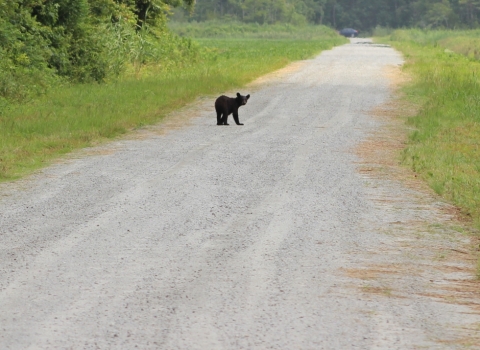Georgetown is one of those islands that was purchased by the Nature Conservancy in 1989, then turned over to the US Fish and Wildlife Service is November 1990 to create the Ohio River Islands NWR.
Erosion is a common problem at all of the river islands. The erosion is caused partly by the wakes of boats as they pass, but more precisely the problem is the depth of the river, which used to be shallow most of the year, sometimes only a few feet deep. Dams on the river, built to ensure a navigable depth year round, essentially keep the river in a constant state of flood. The means the foundation of each island is deeply submerged and that soil of each island is constantly saturated with water, making it for more susceptible to erosion.
When an island is purchased, the area of the real estate includes everything that was within the historic footprint of the island. This means that, in the case of badly eroded islands like Georgetown, the refuge ends up owning much more “land” underwater than above the surface. Each state has different laws dictating how dredge material from the river can be used (the river is dredged, again, to maintain navigable depth). Pennsylvania allows the refuge to use dredge material to rebuild refuge islands to their original proportion.
Georgetown is the first island to benefit from this. Through an agreement with the US Army Corps of Engineers, fill that is determined to be acceptably free of contaminants may be used to rebuild the island. A ring of rocks is constructed several dozen feet out from shore, and the dredge material is used to fill in behind this ring of rocks. Another ring or rocks can then be added and filled in, and on and on; the island is grown out one ring at a time, like the rings of a tree.
****************************
Adopted from an article, “History of Ohio River Islands Brought to Light,” from The Times, Beaver County Times and Allegheny Times Inc.:
“Georgetown Island served as a fruit and vegetable patch for Depression Era Midland residents. John Cerasi (b. 1932) of Ohioville said his father, Luigi, was one of the first to grow vegetables on the island during the Depression. Midland was filled with gardens during that era, and the island offered a wide space for planting. Cerasi’s dad got permission fro Crucible Steel, which owned the island, to plant there. A lot of others followed his lead, but Luigi’s garden was the largest, about two acres. “He grew everything: watermelon, cantaloupe, potatoes, peanuts – everything,” John said. “He had Concord grapes completely around the garden and peach trees; he must have had eight, 10 peach trees.”
His father had a boat that he tied to a tree on the riverbank. He kept the oars in a nearby box that was secured with a padlock. Neighbors, who lived on the hills above the river, would keep a close watch for anyone goin there to steal the produce. That still didn’t stop the kids from sending raiding parties over on hand-built rafts.
Luigi Cerasi built a two-story shed for his equipment from wood he collected off the riverbank during a flood in 1936, one of the worst in county history. He also built swings and a see-saw for the kids. Every Labor Day, the Cerasis and their neighbors would have a large picnic on the island.
John Cerasi’s older siblings had the job of carrying the harvest from the boat up two steep hills to the road, where they piled it in a large wagon with steel wheels and pushed it home. Gardening on the island stopped after World War II began, Cerasi said. “Once the war stated and people started working good in the mill, they kind of got away from gardening then,” he said.
Midlands kids called the area ‘stinky water’ for the raw sewage that spilled into the river before the borough built a wastewater treatment plant. (John Cerasi remembered the swimming hold also had the name “bareass beach”). “All the kids went down there,” said Beaver County Commisioner Dan Donatella (b. 1937) who grew up in Midland. “I can vividly remember swimming in the river, and here comes a big oil slick, or here comes raw sewage, and you’d try to brush it away. We didn’t know any better. When I look on it now, I can’t believe none of us got a disease.”
Dan said Midland kids played a game while hiking to Georgetown Island at the town’s western border. During the simmering days of summer, they would walk barefoot on sun-scorched railroad tracks that led to the local swimming hole. The first one to jump off the tracks was the chicken. Swimming out o the island was a test of bravery for the Spring Lane Boys, the kids who lived at the western end of Midland. Donatella parents forbade him to go anywhere near the river, but it was a powerful lure for boys growing up during World War II. He went anyway, despite the threat of a whipping, which he got once after his father caught him on the riverbank. “That literally was the playground for the boys,” Donatella said. “That’s where everybody hung out. I can’t believe how crazy we were. When I think back now about what we did then, I’d murder my kids if they did that.”
Island Access: Ohioville Borough Boat Ramp, Calcutta Rd off SR 39/68, Midland, PA


